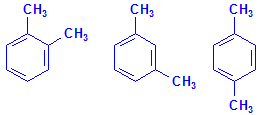The three aromatic hydrocarbons that have been used are benzene, xylene and toluene. Of these, benzene is now very strongly deprecated for health reasons. It is a known carcinogen and causes liver damage. It should not be used at all.
Xylene

Xylene, also known as xylol and dimethybenzene, is probably still the most common clearing agent as it is reasonably fast and effective, and it mixes well with paraffin wax. As you can see from the structural formulae to the left, xylene has three isomers, differing by the placement of the two methyl groups. They are ortho-, meta- and para-xylene respectively, left to right. For histological purposes it does not matter which isomer is used, and histological grade xylene is often provided as a mixture of all three.
Xylene is an efficient fat solvent, and that is one of its major advantages. Triglyceride can mix with paraffin wax and soften it if they remain in the tissue. The fat itself is also too soft to section thinly. Its presence has a distinctly negative effect on the quality of sectioning, and should be completely removed. Xylene does this if applied for an adequate length of time.
There is a visual clue given by xylene. It causes an increase in the refractive index of the tissue as the dehydrant is removed. Eventually, when complete, the tissue becomes quite translucent, and almost transparent. Generally only three changes of xylene are required to reach this stage. If the tissue remains opaque it means that either water or ethanol remains in the tissue. If the opaqueness is very white it is probably water.
Xylene does tend to harden tissues a little, but this does not usually interfere with sectioning qualities. One very distinct defect, though, is that it may reharden decalcified bone excessively. This is not too much of a problem with the softer cancellous bones encountered, but it can make sectioning of decalcified long bones extremely difficult, if not impossible. Avoid xylene under these circumstances. Chloroform is a much better choice.
Toluene

Toluene, also known as toluol and methylbenzene, is less common than xylene but does have a distinct and loyal following. As you can see from the formula it is closely related to xylene, but with a single methyl group. There is not much to choose between the two fluids, although some people find the aroma of toluene more objectionable than that of xylene.
In general toluene is much like xylene in characteristics. It also raises the refractive index of the tissue and gives a visual cue on completion of clearing.






